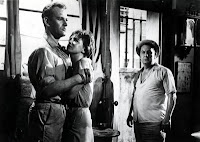Another year, another list of the 10 classic movies I saw for the first time this year which were great, enjoyable, or interesting, with the dates of the month in which I reviewed them here:
FOLLOW ME QUIETLY (1949; rev. 11/09): Creepy police thriller with William Lundigan tracking down a serial killer called The Judge; short and low-budget but with atmosphere to beat the band.
THE HEART OF THE MATTER (1953; rev. 4/09): Intelligent, well-acted adaptation of a Grahame Green novel about an unhappy British policeman in colonial Africa who finds his world coming apart.
THE KILLERS (1964; rev. 11/09): Remake of a classic 1946 film noir; this one is less atmospheric but more brutal and violent, and acted very well by John Cassavetes, Angie Dickinson, and Lee Marvin.
MURDER IN THE RED BARN (1935; rev. 1/09): Old fashioned, over-the-top melodrama with thunder and dark houses and twirling mustaches.
LA RONDE (1950; rev. 9/09): Frothy, sexy, episodic French concoction about a group of people involved in a circular chain of love affairs.
SEARCH FOR BEAUTY (1934; rev. 5/09): Fun, risque pre-Code comedy about a couple of scammers setting up a health spa and getting their comeuppance at the hands of two Olympic athletes; notable for its flashes of near-nudity (both male and female).
SHACK OUT ON 101 (1955; rev. 8/09): Dirty commie spies who use a grungy seaside diner as a place to pass secrets are hunted down by a college professor--or is he one of them? Lee Marvin gives a great B-film performance as the chief bad guy.
TENSION (1949; rev. 12/09): A wonderful low-key noir thriller with all the right elements: an urban setting, nighttime action, a conflicted hero, a femme fatale, moral gray areas, betrayal, and cops. Richard Basehart is good as the hero but Audrey Totter is fabulous as the bad gal.
TWO THOUSAND WOMEN (1944; rev. 3/09): A wartime thriller with a different setting, an old hotel in France being used by the Germans as an interment camp for women; not terribly exciting but engrossing, with a great Hitchcock moment during a concert scene near the climax.
UNCLE SILAS (1947; rev. 10/09): Grand Gothic melodrama of a young girl and her guardian, an uncle who seems at first pleasant if eccentric but soon reveals himself to be a villain who will do anything to get his hands on her inheritance; one of the best film adaptations of a Gothic novel.
I also enjoyed other noir/crime films such as THE BIG HEAT (this was a good Lee Marvin year for me) and THE PHENIX CITY STORY; Douglas Fairbanks Sr.'s wonderfully surreal short THE MYSTERY OF THE LEAPING FISH; the antic British comedy THE WRONG BOX; the
 near-screwball THE YOUNG IN HEART; the bizarre anti-war musical OH WHAT A LOVELY WAR; the fun B-mystery THE CIRCUS QUEEN MURDER; and the 60's-influenced re-telling of the life of St. Francis BROTHER SUN SISTER MOON.
near-screwball THE YOUNG IN HEART; the bizarre anti-war musical OH WHAT A LOVELY WAR; the fun B-mystery THE CIRCUS QUEEN MURDER; and the 60's-influenced re-telling of the life of St. Francis BROTHER SUN SISTER MOON.Sometimes it seems like they're scraping the bottom of the barrel for DVD sets, but this year, I loved the pre-Code sets from Warners (the 3rd Forbidden Hollywood) and Universal (which contains SEARCH FOR BEAUTY), the Douglas Fairbanks "Modern Musketeer" box, and boxed sets of Hammer films, Joan Crawford films, and B-screwball films. Boxed sets have become the savior of many little movies that ordinarily would never get released on DVD, except they happen to belong to a genre (film noir sets are especially common) or fit a theme (studios, stars).
































